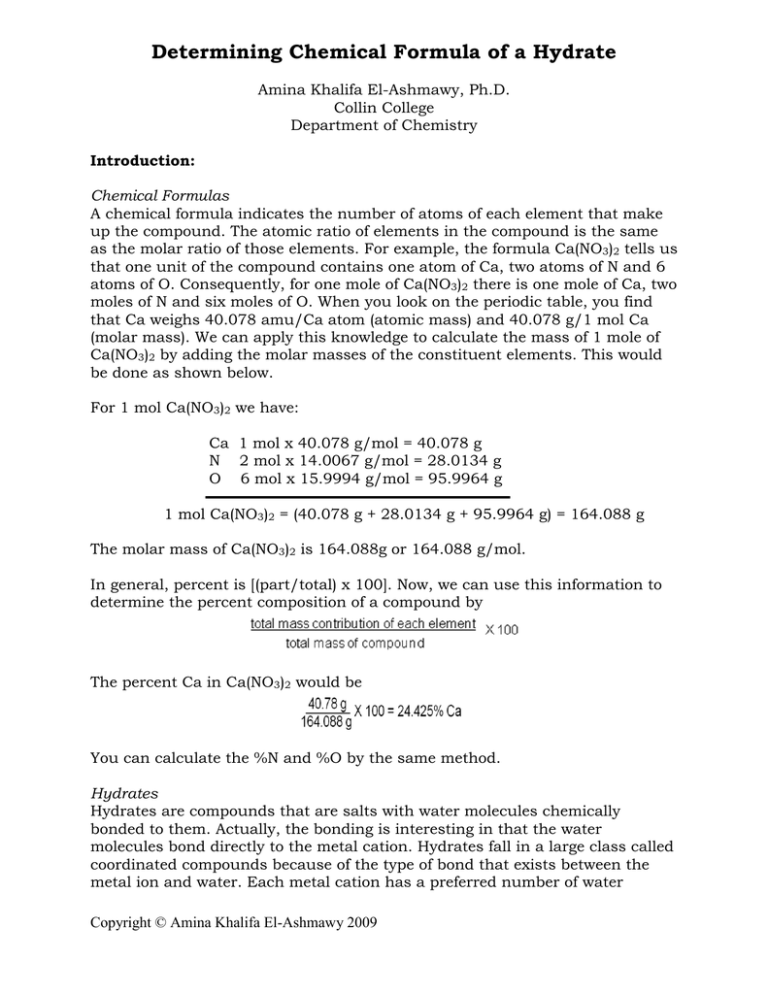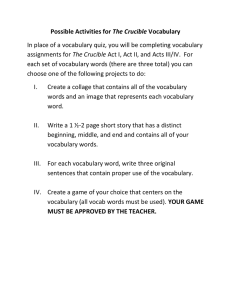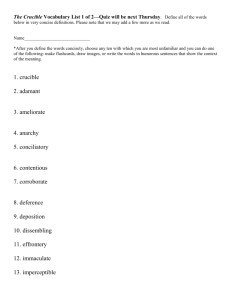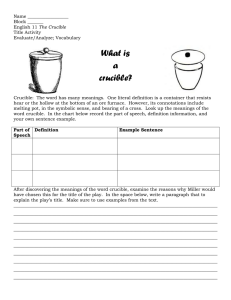Determining Chemical Formula of a Hydrate
advertisement

Determining Chemical Formula of a Hydrate Amina Khalifa El-Ashmawy, Ph.D. Collin College Department of Chemistry Introduction: Chemical Formulas A chemical formula indicates the number of atoms of each element that make up the compound. The atomic ratio of elements in the compound is the same as the molar ratio of those elements. For example, the formula Ca(NO3)2 tells us that one unit of the compound contains one atom of Ca, two atoms of N and 6 atoms of O. Consequently, for one mole of Ca(NO3)2 there is one mole of Ca, two moles of N and six moles of O. When you look on the periodic table, you find that Ca weighs 40.078 amu/Ca atom (atomic mass) and 40.078 g/1 mol Ca (molar mass). We can apply this knowledge to calculate the mass of 1 mole of Ca(NO3)2 by adding the molar masses of the constituent elements. This would be done as shown below. For 1 mol Ca(NO3)2 we have: Ca 1 mol x 40.078 g/mol = 40.078 g N 2 mol x 14.0067 g/mol = 28.0134 g O 6 mol x 15.9994 g/mol = 95.9964 g 1 mol Ca(NO3)2 = (40.078 g + 28.0134 g + 95.9964 g) = 164.088 g The molar mass of Ca(NO3)2 is 164.088g or 164.088 g/mol. In general, percent is [(part/total) x 100]. Now, we can use this information to determine the percent composition of a compound by The percent Ca in Ca(NO3)2 would be You can calculate the %N and %O by the same method. Hydrates Hydrates are compounds that are salts with water molecules chemically bonded to them. Actually, the bonding is interesting in that the water molecules bond directly to the metal cation. Hydrates fall in a large class called coordinated compounds because of the type of bond that exists between the metal ion and water. Each metal cation has a preferred number of water Copyright © Amina Khalifa El-Ashmawy 2009 molecules to which it bonds. Some metals can form multiple hydrates. It is not critical to understand the bonding at this point. Just realize that strong heating of hydrates will result in the water-metal bonds to be broken, which is called dehydration. The product salt is called an anhydrate, “without water.” If the weights of the hydrate and its resulting anhydrate are measured, you can use the Law of Conservation of Mass to determine the weight of the water originally present in the hydrate. One can calculate the molar ratio of water to salt and determine the hydrate’s formula. Formulas for hydrates are typically written in the form salt•xH2O, where x is the moles of water that bond with each mole of the salt. Gravimetric analysis is a method whereby one uses weight to quantitatively determine the composition of a solid analyte, the substance being analyzed. It is a simple and effective technique. The Problem: You will be experimenting with a decomposition reaction (dehydration) and determining the formula of the hydrate. Handling Crucibles: In order to strongly heat chemicals to cause a reaction, one typically uses a ceramic crucible and lid. Ceramic in general is very porous and absorbs things from the air as well as oils from the skin. Before using a crucible, one must strongly heat the crucible and lid with a Bunsen burner while the crucible and lid are on a clay triangle. The crucible should sit on the clay triangle rather sit in the clay triangle. In addition, the lid should not fit exactly on the crucible but rather sit on top of the crucible. (If the lid fits perfectly on the crucible, upon heating and cooling the lid will get sealed onto the crucible making it impossible to remove the lid.) Crucibles may have baked in chemicals from previous use. If so, it is necessary to add a couple of drops of concentrated nitric acid to react any loose residue. Once the crucible and lid are strongly heated the first time, they should not be touched throughout the remainder of the experiment. They can be transported from bench top to balance using crucible tongs. Students should practice handling the crucibles with crucible tongs before beginning the experiment. Remember that only room temperature items can be weighed on the electronic balance. Since you cannot touch the crucible to determine whether it has cooled off enough to be weighed, you can approach the crucible with the back of your small finger (nail side) without touching. If you feel heat radiating from your crucible, it needs further cooling. Unlike Pyrex©, the ceramic crucible is quite sensitive to sudden changes in temperature. Thermal shock will cause a crucible to break. To avoid breaking the crucible after strong heating, place the hot crucible and lid on a wire gauze or cooling pad. If the crucible breaks at any point, you must start over by cleaning and strongly heating another crucible before adding the reactant(s). Copyright © Amina Khalifa El-Ashmawy 2009 Extreme caution must be taken when using concentrated nitric acid. Open the nitric acid bottle only IN THE HOOD in order to minimize exposure to nitric acid fumes. Your instructor will advise you of the proper disposal for the used nitric acid. Prelab Questions: You will carry out a decomposition reaction, specifically dehydration of a hydrate. You will use a crucible and cover to carry out the decomposition reaction. Following are questions to consider before doing the lab. How do you ensure the crucible is clean? What additional equipment/labware will you need? What is the proper technique for using the labware? How long must you heat the contents of the crucible? How do you know when the reaction is complete? What do you expect the product to look like relative to the hydrate? What are the possible formulas for the following hydrates? CaCl2, ZnSO4, MgSO4, CuSO4 What is the percent H2O in each of the known hydrates? Critical Data/Discussion to Include in Your Lab Report: All data collected Calculations used to arrive at the empirical formula of your compound and percent water in hydrate Balanced chemical reaction Analysis of your formula: What does it mean? What should it have been? Percent error for the percent water in your product relative to the expected percent water Discussion of the formula and possible sources of error Work cited Copyright © Amina Khalifa El-Ashmawy 2009




